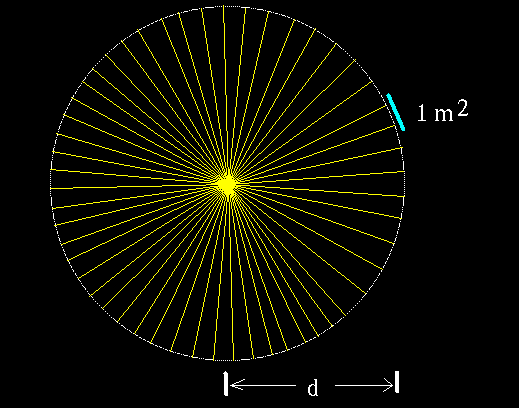Stellar luminosity
In this class, we will describe how bright a star really
is by its luminosity.
The luminosity is how much energy is coming from the per second. The
units are watts (W).
Astronomers often use another measure, absolute magnitude.
Absolute magnitude is based on a ratio scale, like apparent
magnitued. I think it is confusing.
The luminosity of the Sun is
Lsun = 3.9 x 1026 W
We will often measure luminosities of stars in units of the
luminosity. That is, we might say for a certain star
Lstar = 5.2 x Lsun, meaning that the
star has 5.2 times the energy output per second of the Sun.
Measuring luminosity
Since we can't go to a star to measure its luminosity, we have
to be clever. If we know the distance to the star
we can do it, because there is a simple relation between
- the distance d to the star,
- the apparent brightness b of the star, and
- the luminosity L of the star.
The relation is

This relation is based on conservation of energy. Consider
an observer a distance d from the star. How much
energy crosses a square meter detector that this observer has?
- All of the energy produced by the star per second must cross
a sphere of radius d.
- The study of geometry tells us that area of this sphere is 4 Pi d2.
- a 1 m2 detector gets a fraction
(1 m2)/(total area)
of this.

Note that the brightness decreases proportionally to the square of the
distance as one moves away from the star. This can be demonstrated
experimentally in the laboratory.
We can write the relation so that it gives L in terms
of b and d.
- It is easy to measure the apparent
brightness b (e.g. with a telescope and a CCD).
- It is not so easy to measure the distance, but we have already
seen something about how that can be done.
- Putting these toghther, we get L.
Luminosities of stars
One finds
- There are a few stars that are more luminous than the Sun.
- For instance, Betelgeuse has L ~ 14000 x Lsun.
- Most stars are less luminous than the Sun.
- For instance, Lstar ~ 0.001 x Lsun
is not unusual.
- There are lots more low luminosity stars than high luminosity
stars.
Davison E. Soper, Institute of Theoretical Science,
University of Oregon, Eugene OR 97403 USA
soper@bovine.uoregon.edu


